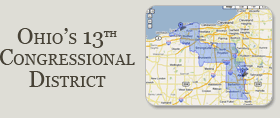Search
District Map
-
The 13th Congressional District & Map
Ohio's 13th Congressional District truly is a great place to live, raise a family and do business. Congresswoman Sutton has lived most of her life in and around the communities that make up much of the district, and she is proud to represent the people and places she knows and loves so much.
Originally nicknamed the “Turnpike District”, the 13th Congressional District’s unique shape traces across the shoreline of Lake Erie in Lorain County, captures the “Emerald Necklace” of the Cleveland MetroParks and the Cuyahoga Valley National Park, and extends south to include the Portage Lakes State Park in Summit County. The 13th Congressional District is also home to institutions of higher learning such as Lorain County Community College and The University of Akron.
The 13th Congressional District stretches across four of Northeast Ohio’s most populous counties, Lorain, Cuyahoga, Medina, and Summit, and it includes all or some of over thirty communities.
View Ohio's 13th Congressional District in a larger map
Contact Rep. Sutton
E-Newsletter
Constituent Services
 |
Sutton Fights to Protect Great Lakes; Congresswoman requests increased funding to protect the regional economy, human health, and the environment
Mar 16, 2007 Washington, D.C. - Today U.S. Congresswoman Betty Sutton joined several of her colleagues to urge key lawmakers to secure over $217 million to protect the Great Lakes region regional economy, human health, and the environment. Sutton cosigned 4 letters to key committee members to urge full funding for several projects in Ohio and the Great Lakes region.
"The Great Lakes are vital to Ohio's economy and are one of the world's greatest treasures," said Sutton. "Full funding will help ensure that we have a strong regional economy, protect our citizens' health, and guarantee we will continue to enjoy the resources we are so lucky to have in this region for years to come."
The letters requested funding for the following programs:
-
$90 million for the National Coastal Zone Management Program grants which provide approved states funding for projects that preserve, protect, restore, and enhance coastal zone areas.
-
$54 million for the Great Lakes Legacy Program to remove years of industrial pollution from the tributaries to the lakes-up to 1.2 million cubic yards of pollution. This is critical to protecting the health of both humans and wildlife.
-
$25 million for the Environmental and Protection Agency's (EPA) Great Lakes National Program Office (GLNPO). GLNPO is responsible for overseeing the water quality of the Great Lakes and is critical to the sustainability of the Great Lakes natural resources.
-
$16.5 million for the Great Lakes Fishery Commission which is responsible for maximizing the sustained productivity of fish stocks in the region-an industry worth up to $5 billion to the Great Lakes region.
-
$16 million for the Fish and Wildlife Service (FWS) Great Lakes Fish and Wildlife Restoration Program. This program has been critical to restore the fish and wildlife resources in the Great Lakes Basin and encourage cooperative conservation, restoration and management of the fish and wildlife resources and their habitat in the Great Lakes Basin.
-
$9.25 million for Army Corps of Engineers' projects including the construction, operation, and maintenance of the dispersal barriers in the Chicago Sanitary & Ship Canal. This barrier is critical to prevent Asian carp from invading the Great Lakes, which would be detrimental to the ecosystem.
-
$7 million for the International Joint Commission who provides a critical interface with Canada, allowing for cooperative management of our shared Lakes.
###

